Heading out the door? Read this article on the new Outside+ app available now on iOS devices for members! Download the app.
A story from the Backpacker archives
Draco strains against the leash. He’s got his front legs splayed, his back arched and horns held stiffly high, his coin-slot eye staring me down. I can tell what he’s thinking: Keep pulling that rope, pal.
Clay Zimmerman, the man who rented me Draco and his comrades, Lunar and Eclipse, told me that I’d be communicating with the goats by the end of the trip. I’m pretty sure this isn’t what he meant.
I take a half-step toward Draco, then lean backward into the leash right on the “boy” of “That’s a good boy, Draco!” Draco shuffles his hind legs forward. And rests on his knees. I drop the leash and sit on a rock, removing my carefully chosen beige hat to sponge off some sweat. “You’d think I was leading the damn thing to slaughter,” I say to Julia, my companion. She lowers her camera (goat-struggle shot number 6,000) and looks at me. I don’t have to wonder what she’s thinking. “It’s time,” she says.
Time for the spray bottle, she means. Clay had warned me against this tactic. In fact, during the whole three-hour orientation he gave me, this was pretty much the only thing he said not to do. “To be clear,” I’d said, because clarity on this seemed important, “can I use the spray bottle for motivation?”
“Absolutely not,” was his quick answer. “Only for discipline.”
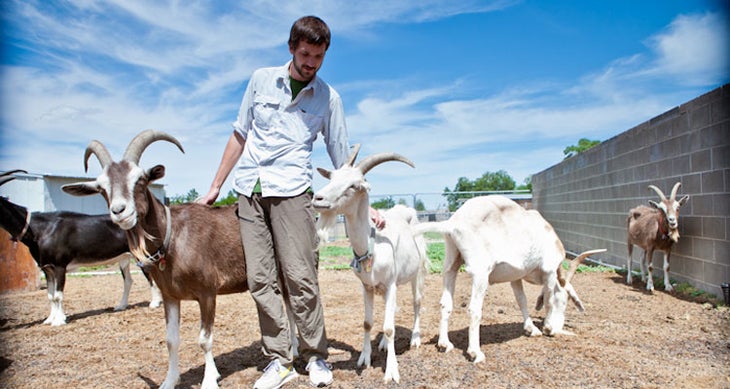
By this point on day two, we should be 10-plus miles into a 50-mile trek along the Highline Trail in Utah’s High Uinta Wilderness, but we’re still within sniffing distance of the trailhead, and I’m pretty sure the goats know it. I’m pretty sure they think if they hold out a little longer, maybe they can bring the whole thing down.
Certainly they’re making a good go at it. My attempts to move the pack string so far have escalated like the verbiage on overdue bills. Sunny enthusiasm gave way to bribery (I’d tried enticing them forward a few feet at a time by dangling treats in front of them—and went through the whole bag of alfalfa pellets in 20 minutes and 20 yards). Then came the plead-and-pull. The goats just chewed their cuds. Totally poker-faced. “The damn things are stonewalling me,” I said, maybe to no one. “They don’t even respect the hat.” (More on that later.)
“I’ve got a new idea,” I’d said to Julia about an hour earlier in almost the exact same spot. “The goats seemed scared of the dark last night. They really hung close to us in camp, right? Maybe if we try to night-hike them, they’ll be too scared not to follow.” Julia encouraged the plan in such a way that I could tell she thought it sucked. The ideas were getting worse. The goats, too. At every chance they got, they’d about-face and hike the other direction. Draco always in the lead.
Draco. At 185 pounds, with splotches of black, white, and beige and a long white stripe running down his nose, he’s the runt of this pack string. Lunar, the largest, outweighs him by 30 pounds, and Eclipse sits somewhere in the middle. Draco stands aloof from the group, exuding annoyance at the amateurishness of all this. I’m thinking he’s the alpha. I’m thinking there’s no better way to change their minds about who’s in charge than to depose the apparent leader. I’m thinking, Casey Lyons, beastmaster.
But when I attempt to put Draco in his place by hauling him into the lead, past Lunar and Eclipse, Lunar lowers his head and gives him the horns, sending me crashing through a stand of saplings to avoid getting gored. I make a go at Lunar, but moving him is like trying to push-start a tank.
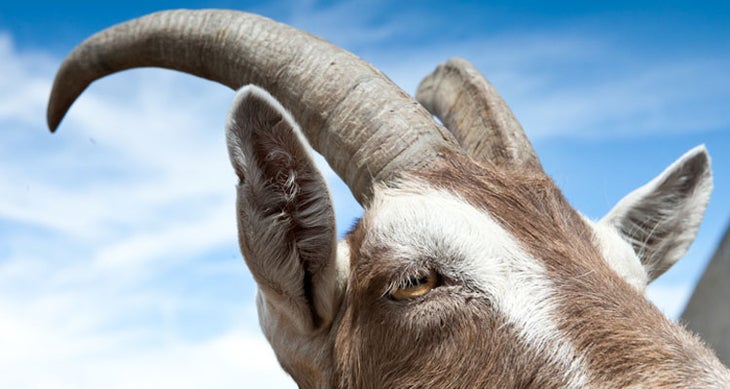
Our options are exhausted now—except for the one. Julia’s been lobbying for the spray bottle for an hour, but up to this point I’ve been reluctant to break Clay’s one rule. And then, sitting trailside on that rock, I experience one of those moments of profound, trip-saving clarity. “What if,” I say to Julia, standing and placing my hat back on my head. “What if, instead of spraying them to get them motivated, we use the bottle to discipline their bad behavior?”
“Okay…”
“Which is being unmotivated.”
“I like where this is going.”
We choose Eclipse, who always seems to be hiding behind something. Julia switches the spray bottle to stream and holds the nozzle a millimeter from his snout. When I pull and he doesn’t come, she bellows forth a bird-scattering “No!” and gives him the business.
It’s like someone shot him out of a cannon.
Let me just say that hiking with goats wasn’t always on my radar. I’d always been interested in the animals, in a spectacle, watch-it-eat-a-tin-can kind of way. But when I heard about goatpacking, I had visions of myself skipping through flowery, alpine fields with just a daypack while a loyal and proud goat followed me like, well, a dog. A dog with a beard and horns. So basically a demon dog. But, you know, friendly.
Nights, my new goat friend would lie by the campfire and I’d lean against him and snack on goat cheese produced by one of his many offspring. Something—definitely not mutton—sizzling on a spit. After dinner, I’d produce my pan flute, and play ancient songs under the bowl of stars—fertility songs, or something about Dionysus and wine, maybe.
And since I am a sucker for wine, cheese, and easy hiking, I was a prime candidate for goatpacking. But don’t think it’s out of (pure) laziness. I once schlepped 60 pounds of water and a birthday cake into Colorado’s Great Sand Dunes National Park after the others I was with had weight-related meltdowns. That time I was the mule. Now I wanted to be on the other side. Plus, goatpacking spoke directly to the part of me that scored “shepherd” on a career aptitude test in college. I needed to try it.
A growing number of hikers have had the same itch over the last decade. They come for the goats’ trail strengths (unlike horses, donkeys, and llamas, the beasts are easy to corral, walk the same pace as people, and since they graze as they go, you don’t have to feed them) and stay for the companionship. Each summer, a small but fervent subculture of goatpackers meet up to swap tips, stories, and sperm from promising sires at a yearly rendezvous put on by the North American Pack Goat Association. The organization counts upwards of 100 members and rising.
In California and the Pacific Northwest, you can hire a wrangler and his flock to transport your gear. But there’s only one person in the country who, for $30 per goat per day (two-goat minimum), will let you take them for a spin all by yourself.
What self-reliant backpacker wouldn’t want to try the DIY version? But first, I needed the perfect hat, an emblem of my authority. Like a Boy Scout leader, or a forest ranger, or a statie, it would have to say, “Here is the kind of man we can follow, unquestioningly, because he has the foresight to protect his neck from the sun.” Something that has visual weight, like a goat’s horn package. And, for me to fit in, it’d have to match their color palette: beige.
That’s how the deluxe Tilley hat and I ended up on Clay’s front porch on a hot July day, looking at a man who looks like a goat. His head is narrow but long, topped with a dense thicket of close-cropped hair, and his set, square jaw hides a row of big teeth that look like they could work a cud. He tells me he’ll grow out the goatee when he retires from the US Civil Air Patrol in a few months.
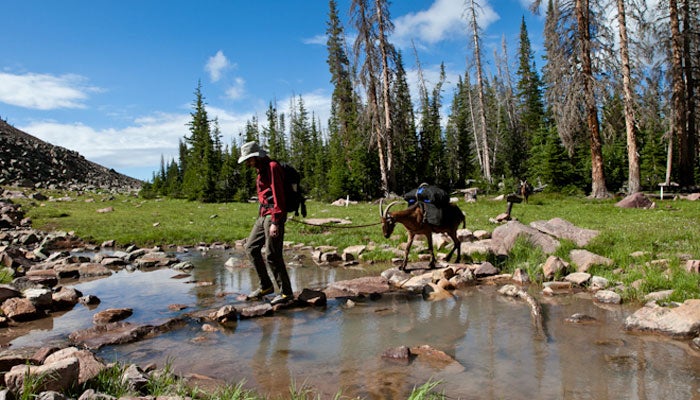
The other thing peculiar about Clay is his voice, big and booming enough to carry across open canyons, which comes in handy for summoning wayward animals. He has the bearing of a career military man with an answer for everything. “Don’t ever touch their horns,” he tells me. “They think of it as a challenge.” And, “Goats hate water. They will do anything to avoid getting their feet wet.”
Then he puts on his beige, full-brimmed hat (for I have chosen wisely) and takes me around back, where his “boys”—all 20 of them—hang in the fenced-in acre that looks like a petting zoo. “Boys” might be misleading. “Boys” makes me think of rec soccer teams and Little League. If regular goats are boys, these dudes are outlaw bikers. It’s not just their on-board weapons (horns); they look like mythical creatures with oversized goat bodies grafted to horse legs. That is exactly the point: Good packers are the tallest and most “gung-ho” (Clay’s word) of the lot. And Clay is their leader. They flock to him, bum-rushing the door to their pen, horns and goatees everywhere. A few let out desperate, longing bleats.
Then, like some pastoral version of Santa, he calls them out by name: There’s Orion, Glacier, Elf, Mask, Wiley, Vulcan, Black-Jack, Tank, Truck, Kiko, Buck, and of course, Bob. He separates out my goats—three of his best packers, he says: Draco, of the Alpine breed, and twin brothers Eclipse and Lunar, both Alpine/LaMancha mixes (and kind of a package deal, hence three goats for our group of two—one per person usually does it). When I pet Lunar, he showers skin flakes from a few saddle-worn spots. It’s like stroking someone’s pet dog—that’s been stuffed for a decade.
Before we can see Rock Creek late on our third day, we can hear it. We drop our packs and the spray bottle at the bank. It doesn’t look far across, maybe 15 feet, but the water is roaring and there’s no sign of stepping stones.
I go in alone first to scout. The creek is freezing—it drains an alpine lake basin, after all—and by my third step I’m in knee-deep. The creek bed, which is obscured below whitewater, is a jumble of semi-smooth river stones. But with a hiking pole for balance and burdened by just a daypack, it’s an easy crossing. I want to say I feel compassion for the goats, bringing them face-to-face with a genetic-level fear like this, but that’d be lying. They’ve been putting me through stubborn hell for half a week, and now it’s payback time.
I’m on the far bank, toweling off my feet when I hear splashing. It’s Julia! And she’s got Eclipse!
She’s a third of the way across by the time Eclipse’s front hoof touches the water, and the force of his balk jerks her to a stop. She wobbles like a drunkard but then, her face flushed (I wasn’t the only one thinking “payback”), she furrows her brow, pulls the leash up onto her shoulder like an old sack, and lurches forward. Eclipse is powerless against momentum like this.
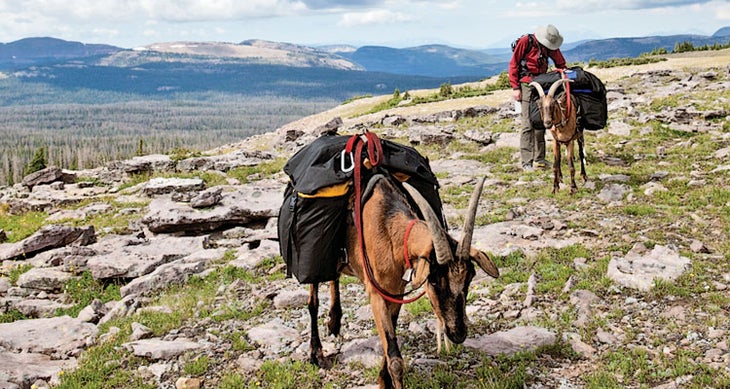
And then the pair is ascending the bank in front of me, like a train running on rage. At the appropriate distance, the leash connecting Eclipse and Lunar jerks taught and he comes. Then Draco’s in the drink. Then we’re across.
And then, maybe 50 yards later, the goats start getting vocal again as we climb away from the river. The bleats grow more savage and depressing as we climb. Suddenly, Eclipse’s knees quiver and his weight teeters forward. He lands hard on his chest, and his head whips forward from his neck and thuds on the ground. Then his tongue rolls out. “So, uh,” I say to Julia. “I think Eclipse might be dead.”
She’s silent.
“Oh, man. Clay’s going to be so pissed.
Still silent.
I pan the scene—a 200-pound animal lying across the trail, its eyes with as much life as the lamb in the butcher shop window.
“What, uh,” I begin, because I am a beige hat-wearing man of solutions. “What should we do with the body? I mean, clearly, we have to take the pack, but, uh, I don’t even know if we can roll him off the trail.”
In Julia’s continuing silence, I remove my hat. Then there’s movement. Eclipse, always hungry, is sliding his head along the ground so he can side-mouth some purple flowers. “He lives!” I say.
And then, perhaps propelled by fear, perhaps because they can smell the far trailhead now, we find a rhythm. Julia and I walk ahead, and the goats, now unleashed, follow just far enough back to keep us within earshot. We stop to wait for them and holler to let them know where we are, then listen for the bells they wear around their necks. From time to time, we hear a distant clinking accompanied by frantic bleating, and we backtrack to find some goat afraid of some puddle. We walk at an overall speed of 1 mph—their pace. They lead us from behind. I have long since packed the hat.
It’s clear now: They’re in charge. In camp, we set down our packs in a grassy meadow. Brown-rock ridges surround us on all sides. Highlights of snow persist in the high-alpine shadows. I remove the goats’ 30-pound packs (an even split between the three of them). Then, I brush and preen the trio one by one. I sink a stake into the earth and tie them to it so they don’t wander off. As we prep dinner, the goats’ bleats are whisked away by the breeze—not exactly the pastoral scene I was imagining, but darn close. More important, the easy pace and light pack let me enjoy the evenings and our bottle (glass!) of peaty scotch, rather than grouse about doing chores after a long day. I’m starting to feel something like companionship as I watch them there working their cuds, indifferent to the mosquitoes and me, doing their thing—sort of like I might feel toward a dog. A dog with a diva temperament that doesn’t really like me. So, you know, the neighbor’s chihuahua.
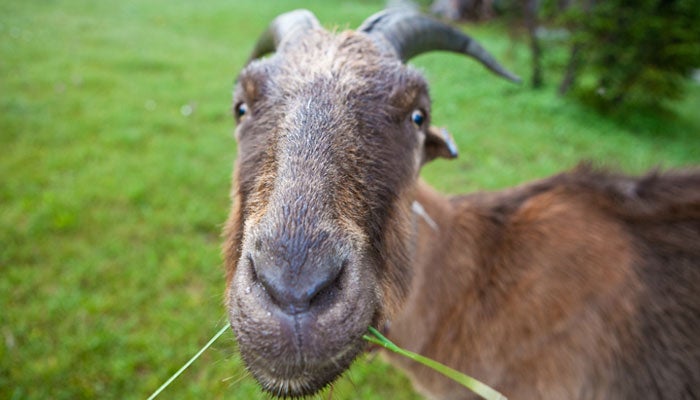
On our final morning, we hike down to Moon Lake, which is thrumming with car campers. We are a sight to behold. “What’s it like hiking with them goats?” a guy asks as we pass. “Harder than it looks,” I answer, which at this point is true. We’re in lock step. We can now anticipate the goats’ confusion; we have them in the correct order—Lunar, Eclipse, Draco—we’re not taking their miscues personally, and we know that we can only go as fast as they can.
Charlotte, Clay’s wife, is waiting for us with the trailer when we get to the trailhead—somehow, despite everything over the last few days, within 20 minutes of when we’d anticipated. We load up and tell her about the trip. She considers it—the slow pace, the difficulties with motivation—then she tells us what she and Clay realized not long after we’d started: A pack goat is ready for the trail at age four, hits his prime at age seven, and is ready for retirement by 10. Both Lunar and Eclipse are 10; Draco is 11. Or, as Charlotte says plainly, “Those goats are old.” In the effort to give us experienced animals, they’d given us ones that are, quite literally, ready to be put out to pasture.
We part ways at the Salt Lake City airport as passersby wonder what a trailer full of goats is doing curbside in departures. I can hear Draco, Eclipse, and Lunar bleating softly as we walk away, but I resist the urge to turn. Sometimes the leader’s grasp over the led—no matter how unshakable it looks—is just a matter of managed perceptions. I tell myself they bleat for me. Casey Lyons, beastmaster.
Former Backpacker Deputy Editor Casey Lyons only wears the beige hat for his wife now.
First published in 2014; last updated in January 2022